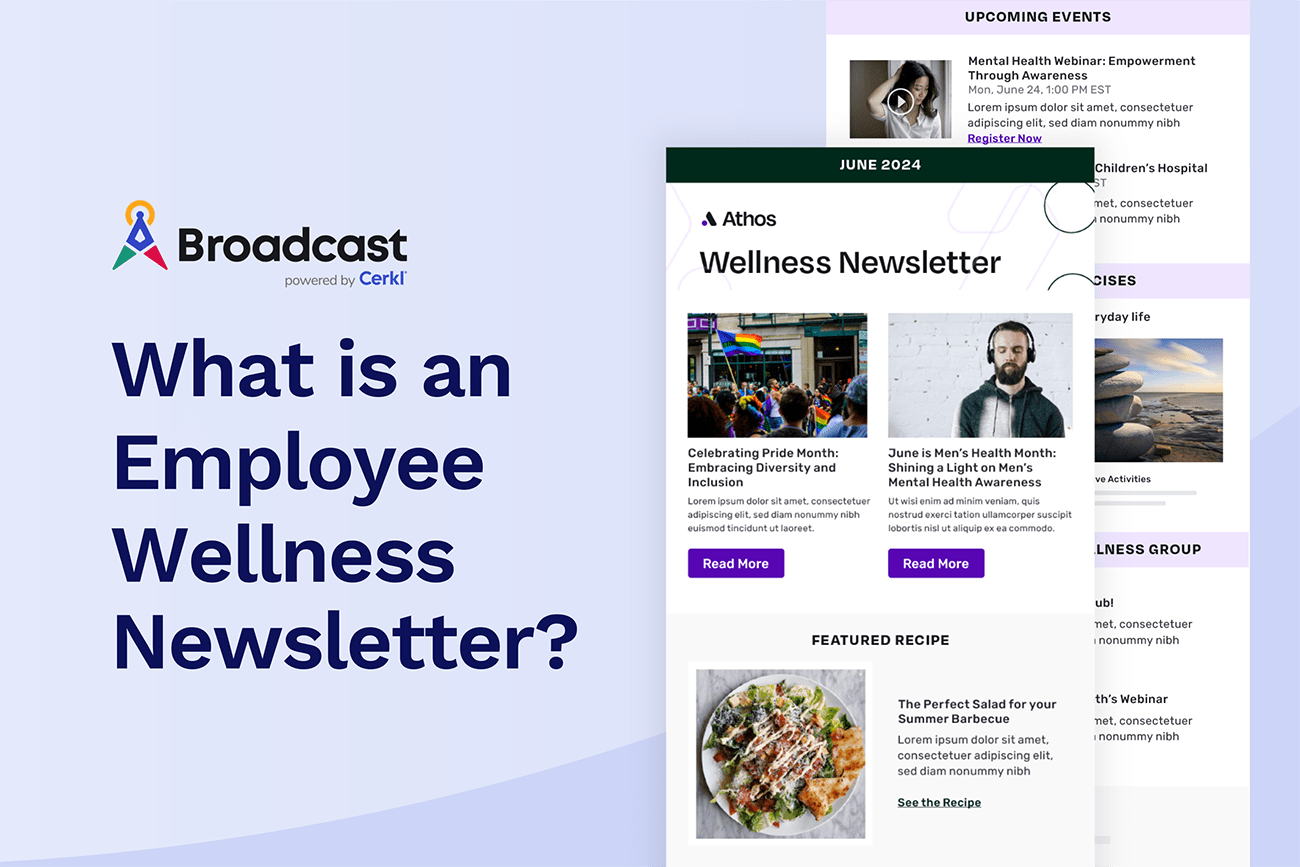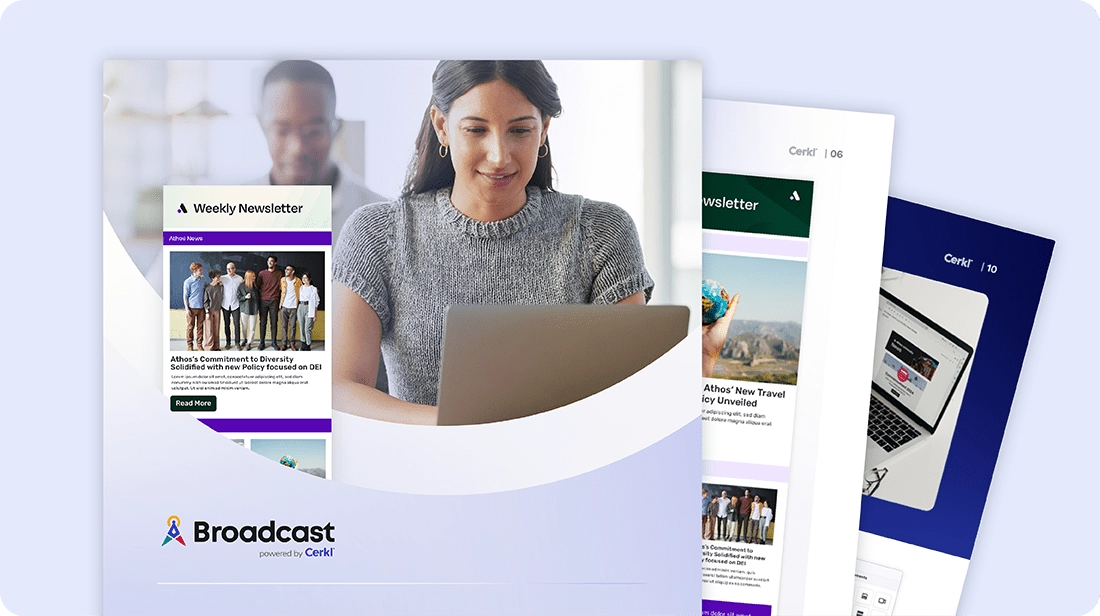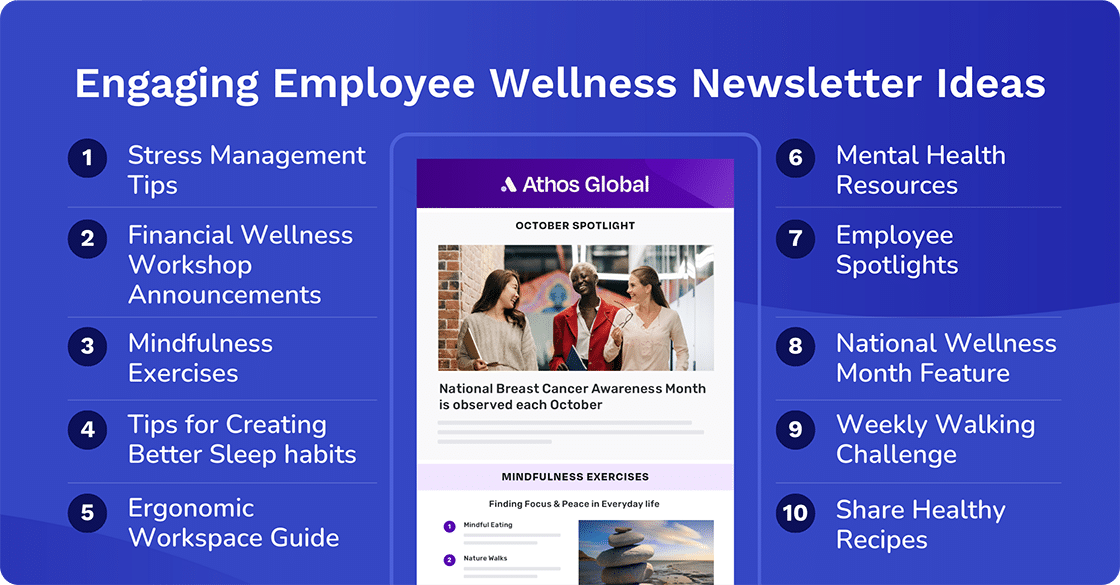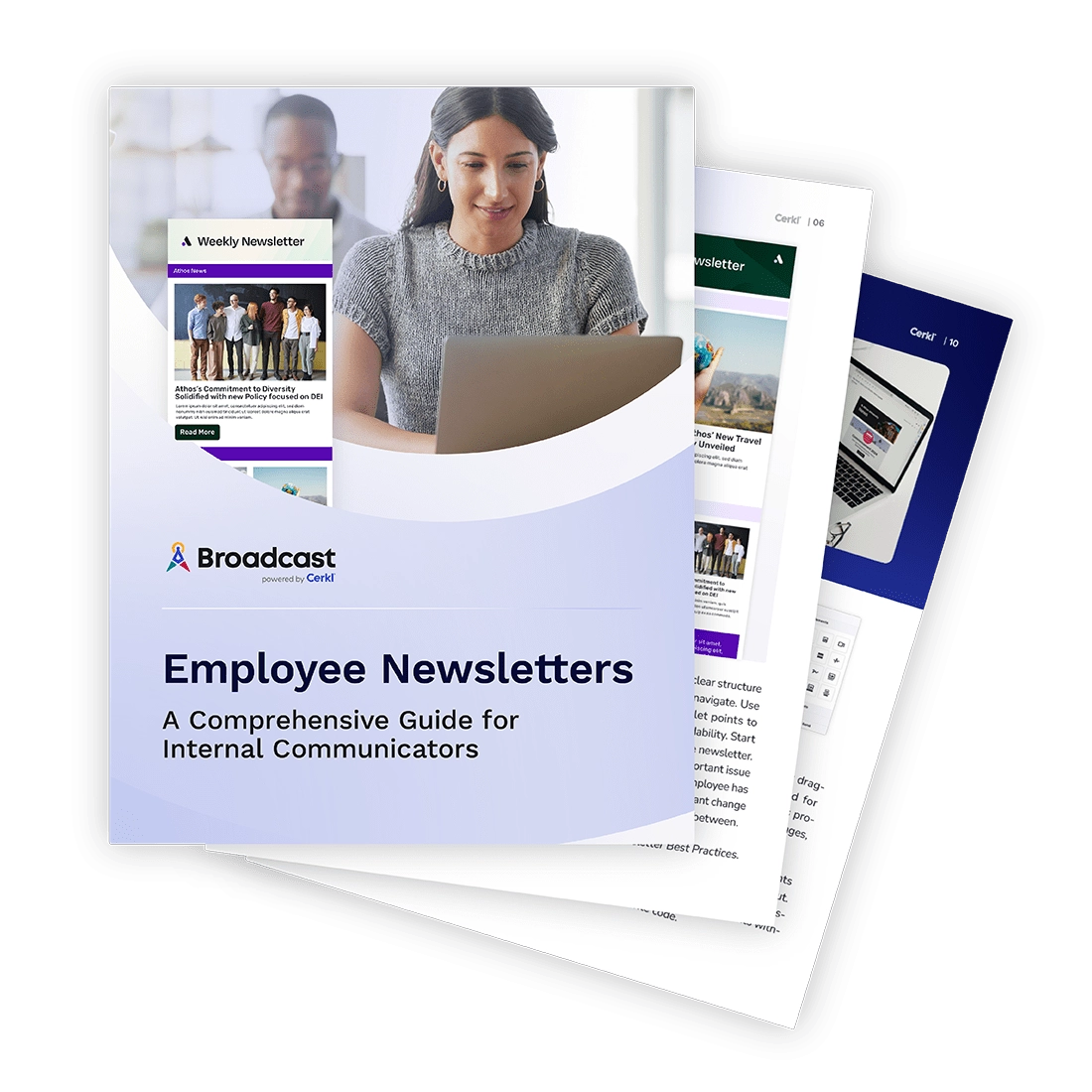If you are in the wellness industry, an employee wellness newsletter might be the best tool you need right now. We’ll tell you why and how to use it.

.webp)
What are the key elements of an engaging employee newsletter? What should not be included in an employee newsletter? Find the answers to those questions and more best practices in our comprehensive guide on creating employee newsletters.
Access NowIn today's fast-paced and often stressful work environment, employee well-being is a critical component of a healthy and productive workforce. As organizations strive to attract and retain top talent, foster a positive company culture, and boost overall performance, prioritizing employee wellness has become a key strategy for success.
A well-crafted employee wellness newsletter can play a vital role in this effort, serving as a powerful tool for promoting healthy habits, reducing stress, and improving the overall quality of life for employees. By sharing valuable resources, expert advice, and engaging content, wellness newsletters can help employees feel seen, heard, and supported, ultimately driving business outcomes and contributing to a happier, healthier workforce.

In an article published in December 2023, Dan Witters, Research Director of the Gallup National Health and Well-Being Index, highlights how physical health plummeted after the Pandemic. The percentage of U.S. adults classified as obese by Gallup has reached 38.4%, while diabetes has reached an all-time high at 25.1%.
Being unwell is stressful, so it isn’t surprising that poor well-being is associated with burnout. In a Gallup podcast, Witters states that the impact of well-being extends far beyond how people feel. It affects how many days employees take off sick, as well as their job performance, odds of burnout, and likelihood of leaving their organization. Leaders who want to attract and retain star talent need to prioritize well-being and take steps to create a thriving culture.
“People with poor well-being are vastly more likely to report that they’ve experienced significant burnout in their jobs than those with high well-being.”
Dan Witters
There are many steps organizations and their managers can take to improve well-being. But that’s not what we’re going to focus on today. Rather, we are going to explore the benefits of employee wellness newsletters.
[cerkl-cro-widget template_id="6"]
Employee wellness goes beyond gym memberships and healthy snacks. It's a comprehensive approach to fostering the physical, mental, emotional, and social well-being of your employees.
Mercer’s Global Talent Trends 2024 focuses strongly on employee wellness and well-being. A few specific takeaways show how employees feel about it, emphasizing why it’s so important.
The evolution of the employee/employer relationship is another valuable takeaway from this report. It shows how this relationship used to be a transactional loyalty contract designed to retain employees. This covered basic needs including pay and benefits. Then, it developed into an engagement contract that was work and workplace-centered. At this stage, it expanded to meet psychological needs including achievements and camaraderie, and rewards were broader.
The current focus, says Mercer, is “thrive contact” that considers the whole person and well-being needs:
Then, there’s a future focus that they predict. It will be a lifestyle contract or life experience (LifeX). Well-being needs will expand to embrace the fulfillment needs of choice, connection, and contribution. There will be more flexibility in terms of rewards and employability, and there will be a focus on “long-term people sustainability.”
Burnout is a growing concern. Nearly a third (32%) of respondents in Mercer’s study said that unless organizations reduce employee burnout they will be exposed to “considerable risk.” They identify the main driver as money.
“Employees spend, on average, six hours of work time per month worrying about their finances, the top driver of burnout risk this year.”
Mercer
But there are other reasons. Another 32% feel overwhelmed by the increase in tech tools, and 20% feel at risk because their values don’t align with those of their employer.
Infinite Potential’s The State of Workplace Burnout 2024 states that 38% of participants in their study were experiencing all three dimensions of burnout. While overall well-being continues to fall., their research shows the percentages have stabilized. But burnout affects everything.
“Burnout isn’t just a buzzword; it’s a productivity killer. Burnout decimates productivity and quality of work. Those who are experiencing burnout report lower productivity and poorer work quality compared to their non-burnt out counterparts. It’s not just a slight dip – it’s a freefall of inefficiency and subpar outputs.”
Infinite Potential
Stressed and overworked employees experience decreased productivity, higher absenteeism, and lower morale. Investing in employee wellness programs can be a game-changer, leading to a happier, healthier, and more engaged workforce.
Deloitte’s The wellbeing crisis is a crisis of leadership focused on organizational crises around mental health and burnout. They say the problem is getting worse.
This may be so, but something to consider carefully is the link between well-being and burnout. The Mercer study found that employees with disabilities were 94% more likely to suffer burnout than the other 79% who weren’t “thriving” at work.
“People with poor well-being are vastly more likely to report that they’ve experienced significant burnout in their jobs than those with high well-being.”
Dan Witters
In case you haven’t guessed, this is the employee wellness newsletter.
Investing in employee well-being or wellness programs can be a catalyst for change. Reward Gateway’s Workplace Wellbeing: Where to focus in 2024 states that while pay is key, 44% of employees believe that a company that cares about their well-being is more important than a 10% pay raise. These are very similar figures to those Mercer published.
But Workplace Wellbeing goes on to add more context. Their survey asked what would have made employees leave their jobs in 2023. There are 10 answers:

So, the question is, how can you change the game?
A well-designed employee wellness newsletter can be a powerful tool for promoting a culture of well-being within your organization. But you need to ensure you include the right content and make it visually pleasing to maximize employee engagement. Taking the main employee pains into account is a good way to start. In this case, a lack of financial, physical, and/or mental well-being support is the line you need to pursue and emphasize.
Guidelines for newsletters that will maximize employee commitment

There are all kinds of elements that will contribute to a winning employee wellness newsletter. The precise design factor involved will depend on your design abilities and experience as well as the platform you are using to create your wellness newsletters.

Guidelines for newsletters that will maximize employee commitment

The channels you choose to distribute your wellness newsletters will determine response and engagement.
A well-crafted employee wellness newsletter can help to boost employee morale and promote healthy habits. We have many engaging ideas to keep your newsletters fresh. But it’s vital to be cognizant of your audience. Not every newsletter is aimed at the same audience.
Here are 10 ideas specifically for employee wellness newsletters:

There are many employee wellness newsletter examples available online. Your challenge will be to find one that appeals to you and your market.
We scoured the internet and found a bunch of wellness newsletters that the HH Health Association has created over the past few years. They are all informative, offering news, health tips, and even regular recipes. You can see that they have based each one on a well thought out newsletter template that they use month after month. These aren’t templates for sale. There are, though, companies that offer templates that might appeal to you.
A healthy and happy workforce leads to a thriving organization. But it can be a challenge to produce the perfect newsletter to share your thoughts, ideas, and inspiration. Cerkl Broadcast can do the rest.
Essentially, you can curate content from various sources and create an engaging employee wellness newsletter. You can personalize your wellness newsletters by using subscriber data to create targeted content. You can automate segmentation to make sure different people get the content they need and want.
Before you start to produce a wellness newsletter, it’s essential to make sure you have your thoughts aligned with the strategy of your organization. This will help you decide on the content for each issue. However, to ensure that it is an effective tool, it needs to be carefully crafted. We have produced a free comprehensive guide to help internal communicators maximize the impact of their employee newsletters.
We discuss everything from suitable formats, design options, and best practices, to delivery design options. Don't miss the opportunity to download it today.

Guidelines for newsletters that will maximize employee commitment
How can I create a wellness newsletter? To create a wellness newsletter, start by defining your target audience and purpose. Then gather content from various sources such as health experts, company wellness programs, and employee testimonials. Use a newsletter platform like Broadcast or another email service provider to design and send the newsletter to your audience on a regular basis.
What is the purpose of a wellness newsletter? The purpose of a wellness newsletter is to educate and engage employees on various aspects of wellness. These include physical health, mental well-being, and stress management. Overall, the goal is to promote a healthy and productive work environment. By sharing relevant content and resources, an employee wellness newsletter will encourage employees to prioritize their well-being and adopt healthy habits.
How do you promote a wellness program at work? If you want to promote a wellness program at work, start by communicating the program's benefits and goals to employees through various channels. For instance, you can use email, posters, and intranet announcements. Additionally, consider hosting events, workshops, and seminars to educate employees on the program's features. Also, be sure to encourage participation, and recognize and reward employees who actively participate in the program.

Guidelines for newsletters that will maximize employee commitment